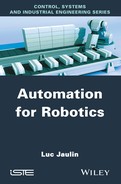Book Description
In order to enable a better understanding of the key concepts of automation, this book develops the fundamental aspects of the field while also proposing numerous concrete exercises and their solutions. The theoretical approach that it presents fundamentally uses the state space and makes it possible to process general and complex systems in a simple way, involving several switches and sensors of different types. This approach requires the use of developed theoretical tools such as linear algebra, analysis and physics, generally taught in preparatory classes for specialist engineering courses.
